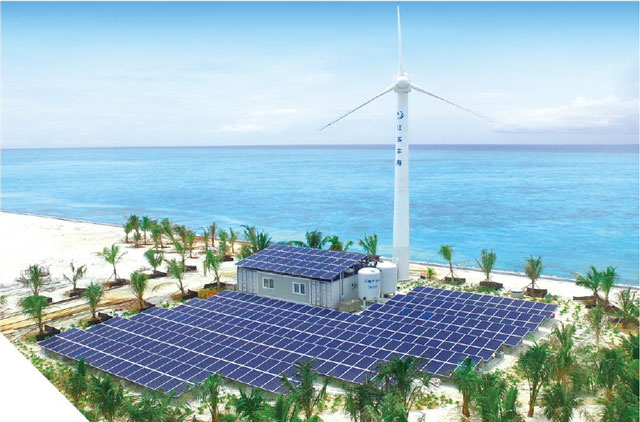The first case in the world! The new-energy desalination equipment puts into use in Hainan!
★The containerized complete system of smart micro-grid seawater desalination is seen to operate independent of grid power by directly utilizing clean energy, e.g. wind energy and solar energy for power generation to produce high-quality drinking water.

★ Guide
On December 31, 2016, ZS Island of Sansha City, Hainan Province, came the good news that the wind-solar-stored energy hybrid smart micro-grid seawater desalination equipment manufactured by Jiangsu Fenghai New Energy Seawater Desalination Development Co., Ltd. (hereafter as “Jiangsu Fenghai”)successfully yielded water, putting end to the history that the ZS island does not produce high-quality drinking freshwater. It also signifies that China’s new energy desalination seawater technology has started to step onto the market and provided “actual combat” experience for the global marketing of new energy desalination equipment.
To make desalted seawater capable of direct drinking is the ultimate goal of the “Human Thirst-quenching Project” that requires water from the sea. At the end of 2016, the National Development and Reform Commission issued the “Thirteenth Five-Year Plan for National Seawater Utilization”, noting that at the end of the “Thirteenth Five-Year Plan” period, the total scale of desalination in the country shall reach over 2.2 million tons per day. It is necessary to desalt the seawater, but also to solve the island’s energy consumption problems. What can be done to remove the “big cap” of energy consumption? The technical innovation provides a solution to the issue.
Energy consumers finally get their own power banks.
High energy consumption has always been a “pain point” for the development of seawater desalination industry. Data show that the conventional seawater desalination is a high energy-consuming industry, which uses conventional energy and requires 46,600KWh to desalt 10,000 tons of seawater, equivalent to 18.8 tons of standard coal, emitting 46.4 tons of carbon dioxide.
The energy consumer had better to have its own “power bank”. Wang Fujia, technical R&D manager of Jiangsu Fenghai said that “it needs an independent power supply system and the power bank cannot be small”. To separate desalination from large power grid and access to new energy, the first 10,000T scale off-grid wind powered desalination demonstration project was built in the coastal area of Yancheng, Jiangsu by Jiangsu Fenghai in May, 2014. The advanced energy management system and parallel control technology for multiple Power Convert Systems (PCS) are adopted to smoothly adjust the variations of the load and ensure the stable operation of the micro-grid system to solve the utilization of new-energy desalination.
Container module is well equipped for direct use.
Zhu Yuzhu, a resident in Sansha city was very happy to drink the desalted water and said “in the past diesel is far from enough for desalting seawater while now wind energy and solar energy are used for producing about 100 tons of fresh water per day according to water demand of the island.”

“Islands are especially lacking in fresh water and electricity,” Wang said, “in the past residents on ZS Island relied on big boats that transported fresh water for them. Each time 5 to 6 tons of water was transported for 150 residents there, which was hardly enough for all purposes except cooking and drinking. They had to wait for rain to bath. Later on they burnt diesel to desalt seawater, but still they had to ship diesel here. Constrained by limited diesel, limited fresh water was yielded for all uses.”

How to apply the designing and operating experience of 10,000T off-grid seawater desalination project to islands? “Large-scale projects are not suitable for islands while thankfully our micro-grid is complete and independent. We’ll make it to micro models realizing plug and play”, said Wang.
The micro models should be easy for transport. With such a goal, Jiangsu Fenghai thought of standard shipping containers. The containerized complete system of smart micro-grid seawater desalination is seen to operate independent of grid power by directly utilizing clean energy, e.g. wind energy and solar energy for power generation to produce high-quality drinking water.
“After the container form is determined, the system is subject to package”, as said by Wang, “just like connecting to computer host, you can connect cables and pipes for it then you may drink desalted seawater”. The containerized equipment adopts different desalination process based on raw water features from different regions. The seawater is processed by pretreatment, stage-1, stage-2 and stage-3 reverse osmosis (RO), etc. “In some regions where the seawater is purer, stage-1 RO water may meet standards for domestic drinking water quality. Stage-2 and stage-3 RO can be added to further remove some ions and make it qualified for direct drinking.”
Aside from the advantages of “entire transportation, fast assembly and commission”, etc., the containerized smart micro-grid seawater desalination system must be resistant to corrosion, typhoon and high temperature. The smart device can run automatically. It can both store energy and supply water. There with this set of equipment, humans can survive on any island.
Source: Science and Technology Daily
Dafeng Radio and Television
Yanfu People's Daily
Dafeng Daily




